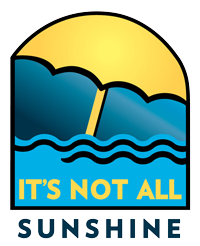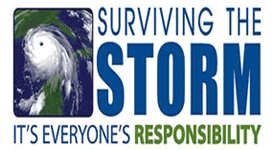 Located on a barrier island, Redington Shores is bounded by the Gulf of Mexico to the West and the Intracoastal Waterway to the East. Hurricanes, tropical storms and other threatening weather can present flood hazards to residents due to high tides, storm surges caused by winds, and heavy rainfall. Flooding and other drainage problems can also result after several inches of rain in a short period of time or after several days of continued rain. Over the past 20 years, Redington Shores has experienced numerous rainfall events causing flood damage. Hurricane season runs from June 1 through November 30. Redington Shores and all of the low-lying beach communities are in a highly vulnerable flood and wind zone area.
Located on a barrier island, Redington Shores is bounded by the Gulf of Mexico to the West and the Intracoastal Waterway to the East. Hurricanes, tropical storms and other threatening weather can present flood hazards to residents due to high tides, storm surges caused by winds, and heavy rainfall. Flooding and other drainage problems can also result after several inches of rain in a short period of time or after several days of continued rain. Over the past 20 years, Redington Shores has experienced numerous rainfall events causing flood damage. Hurricane season runs from June 1 through November 30. Redington Shores and all of the low-lying beach communities are in a highly vulnerable flood and wind zone area.
Find out what your flood risk is and how much flood damage could cost you. Purchase flood insurance, and get a plan now. Clear storm drains and stay connected when there is an impending storm. Remember, turn around don’t drown during a storm. If your property is damaged from flooding, file your insurance claim promptly and find out what building permits you need to build back safer and stronger.
Did You Know?
 Flooding can be caused by heavy rains as well as by tropical storms and hurricanes.
Flooding can be caused by heavy rains as well as by tropical storms and hurricanes.- Everyone in the Town of Redington Shores is in a Special Flood Hazard Area, which has at least a one in four chance of flooding during a 30-year period.
- Homeowner’s insurance policies do not cover losses due to flooding.
- The Town of Redington Shores is located in Hurricane Evacuation Zone A.
- Pinellas County will notify the local news stations about emergencies and you can sign up to receive alerts on your phone or by email.
- Six inches of moving water can make you fall and a foot of water will float many vehicles.
- Dunes protect beaches from erosion and help to lessen flooding during coastal storms.
- The State’s Coastal Construction Control Line (CCCL) program protects beaches and dunes from construction that could weaken, damage, or destroy the integrity of beach and dune systems that help protect against flooding.
- Special needs: Residents who need evacuation assistance should complete the Evacuation Assistance/Special Needs registration form. You can also do this at Town Hall, or can register online on the Pinellas County website.
- Flood insurance technical assistance is available. Visit www.pinellascounty.org/
flooding/advocates.htm to find a flood insurance advocate to answer your questions.
The Towns Part
The Town of Redington Shores has a comprehensive Floodplain Management program to protect you and your loved ones from severe weather and flooding, reduce property damage, and protect the environment. Additionally, the Town participates in the National Flood Insurance Program (NFIP) and Community Rating System (CRS) to ensure flood insurance is not only available to its residents, businesses, and property owners, but is offered at a discount. The Town is doing a number of things to sustain its Floodplain Management and CRS programs, such as:
- Developing and implementing a Program for Public Information (PPI) and its associated outreach projects and initiatives, such as this flood information website
- Providing flood services, such as, flood map information, property protection advice, and flood insurance technical assistance.
- Adopting and enforcing floodplain ordinances, such as freeboard
- Maintaining and protecting open spaces and natural systems throughout town, including our parks, beach, dunes, and mangroves
- Participating in the multijurisdictional Pinellas County Local Mitigation Strategy (LMS) and maintaining a Town of Redington Shores Floodplain Management Plan.
- Participating in the National Pollutant Discharge Elimination System (NPDES) and maintaining our drainage system.
- Implementing a Capital Improvement Program
- Coordinating with County and State Emergency Management
To a large extent, the success of the programs depends on the cooperation and assistance of residents, businesses, and property owners to make it work.
What You Can Do
Prepare Ahead
Severe weather and associated flooding can occur at any time. When you are in danger, their first instinct is to dial 9-1-1 for help. But in extreme situations, normal rescue procedures can’t always be used. By being properly prepared, you can better protect yourself, your loved ones, and your property.
Clear Storm Drains
Maintaining stormwater drainage requires your cooperation and assistance to prevent flooding and pollution. If you see a blocked storm grate or curb inlet, please clear it. Remember, Only Rain Down the Drain; If you see anyone dumping trash, lawn clippings, etc., contact the building department. If seen at night or weekends contact the police department at (727) 595-5414.
Get a Building Permit
To minimize flood damage to buildings and avoid increased flood depths, the Town has specific requirements for all new or substantially improved buildings. These requirements help protect the structure against movement by floodwaters and better resist flood forces and prevent additional runoff from the property.
As a participant in the NFIP and NPDES the town has adopted ordinances on building construction, Stormwater drainage, filling, grading, and excavation. If you see any construction or excavating done without a permit posted, contact the building department.
Get Involved!
Program for Public Information (PPI): The PPI Committee is looking for volunteers from condominium and associations and neighborhoods to help relay important flood information messages to the associations’ residents.
 Community Emergency Response Team (CERT): CERT is a community based organization of residents who learn how to take emergency response actions in safe ways until the professional emergency responders can respond. These citizens learn how to work in a coordinated manner caring for those citizens within their community affected by a disaster.
Community Emergency Response Team (CERT): CERT is a community based organization of residents who learn how to take emergency response actions in safe ways until the professional emergency responders can respond. These citizens learn how to work in a coordinated manner caring for those citizens within their community affected by a disaster.
Visit https://www.fema.gov/community-emergency-response-teams for more info.
Contact the Town to find out about volunteer opportunities!
- Your Guide To Flood Information in the Town of Redington Shores
- Map Changes and Flood Insurance: What Property Owners Need to Know

